sensor JAGUAR S TYPE 2005 1.G Technical Guide Update
[x] Cancel search | Manufacturer: JAGUAR, Model Year: 2005, Model line: S TYPE, Model: JAGUAR S TYPE 2005 1.GPages: 133, PDF Size: 3.48 MB
Page 109 of 133
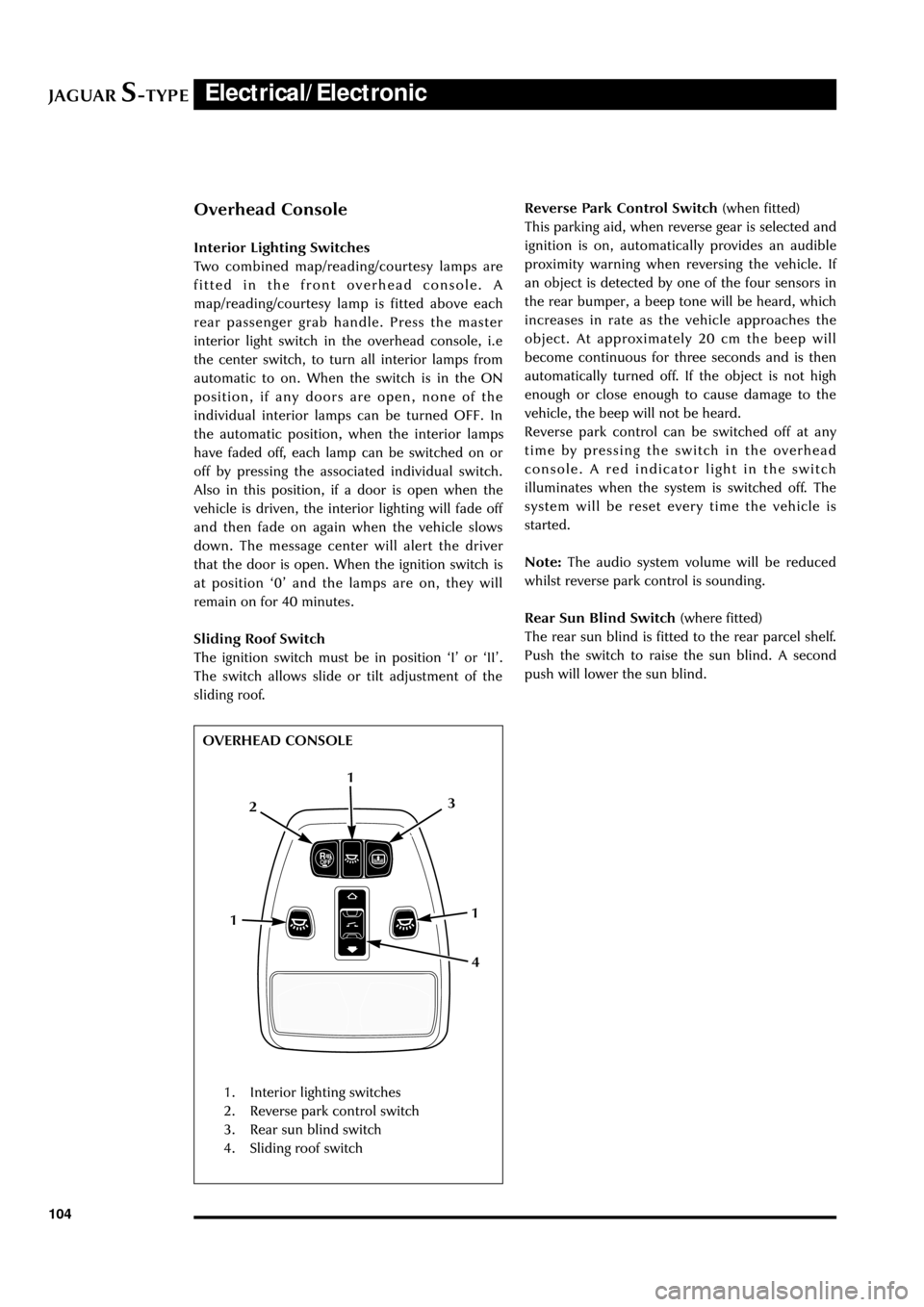
JAGUARS-TYPEElectrical/Electronic
104
Overhead Console
Interior Lighting Switches
Two combined map/reading/courtesy lamps are
fitted in the front overhead console. A
map/reading/courtesy lamp is fitted above each
rear passenger grab handle. Press the master
interior light switch in the overhead console, i.e
the center switch, to turn all interior lamps from
automatic to on. When the switch is in the ON
position, if any doors are open, none of the
individual interior lamps can be turned OFF. In
the automatic position, when the interior lamps
have faded off, each lamp can be switched on or
off by pressing the associated individual switch.
Also in this position, if a door is open when the
vehicle is driven, the interior lighting will fade off
and then fade on again when the vehicle slows
down. The message center will alert the driver
that the door is open. When the ignition switch is
at position Ô0Õ and the lamps are on, they will
remain on for 40 minutes.
Sliding Roof Switch
The ignition switch must be in position ÔIÕ or ÔIIÕ.
The switch allows slide or tilt adjustment of the
sliding roof.
JOL.172
OVERHEAD CONSOLEReverse Park Control Switch (when fitted)
This parking aid, when reverse gear is selected and
ignition is on, automatically provides an audible
proximity warning when reversing the vehicle. If
an object is detected by one of the four sensors in
the rear bumper, a beep tone will be heard, which
increases in rate as the vehicle approaches the
object. At approximately 20 cm the beep will
become continuous for three seconds and is then
automatically turned off. If the object is not high
enough or close enough to cause damage to the
vehicle, the beep will not be heard.
Reverse park control can be switched off at any
time by pressing the switch in the overhead
console. A red indicator light in the switch
illuminates when the system is switched off. The
system will be reset every time the vehicle is
started.
Note:The audio system volume will be reduced
whilst reverse park control is sounding.
Rear Sun Blind Switch (where fitted)
The rear sun blind is fitted to the rear parcel shelf.
Push the switch to raise the sun blind. A second
push will lower the sun blind.
1. Interior lighting switches
2. Reverse park control switch
3. Rear sun blind switch
4. Sliding roof switch
12
1 1
4 3
Page 110 of 133
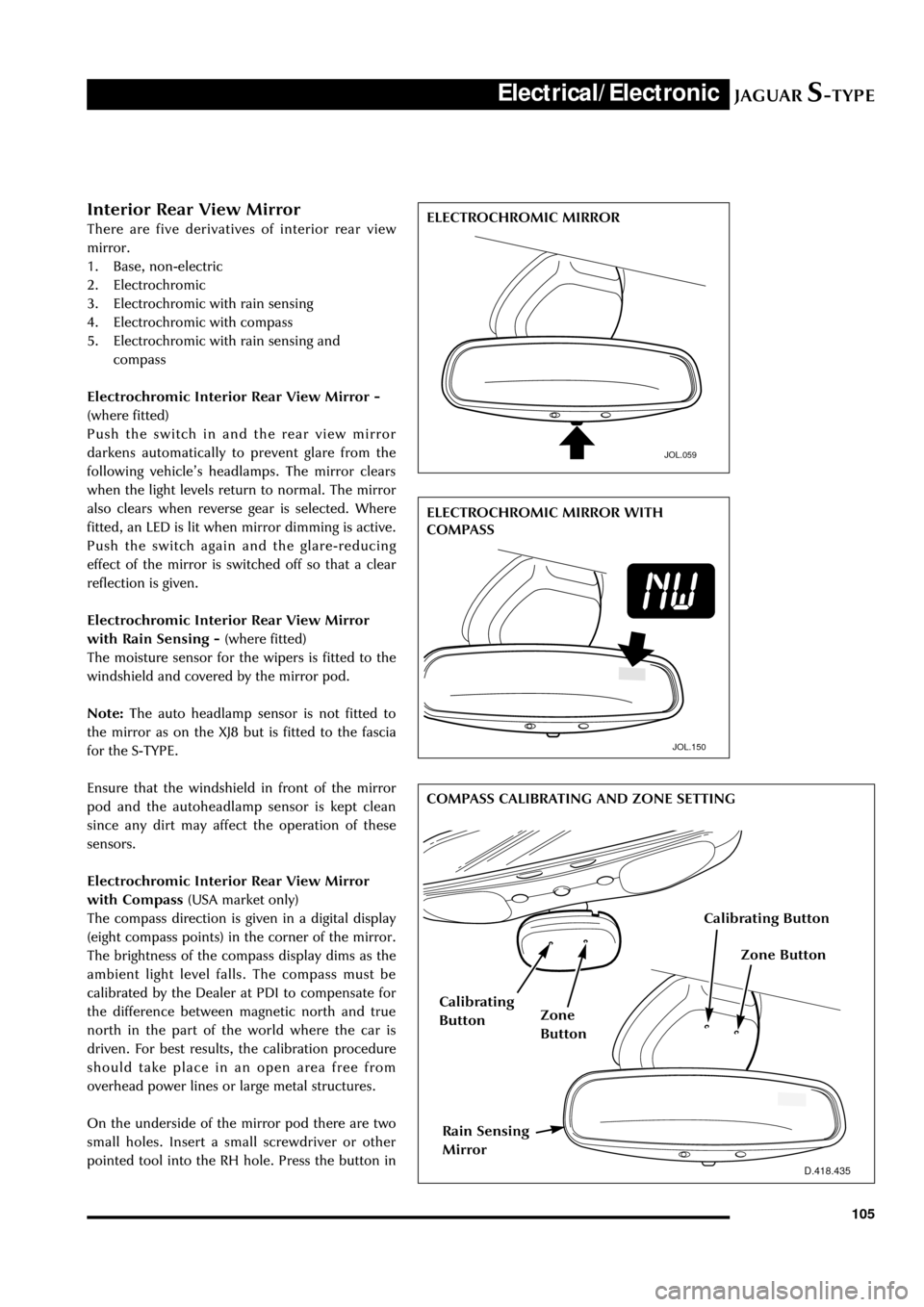
JAGUARS-TYPEElectrical/Electronic
105
Interior Rear View Mirror
There are five derivatives of interior rear view
mirror.
1. Base, non-electric
2. Electrochromic
3. Electrochromic with rain sensing
4. Electrochromic with compass
5. Electrochromic with rain sensing and
compass
Electrochromic Interior Rear View Mirror -
(where fitted)
Push the switch in and the rear view mirror
darkens automatically to prevent glare from the
following vehicleÕs headlamps. The mirror clears
when the light levels return to normal. The mirror
also clears when reverse gear is selected. Where
fitted, an LED is lit when mirror dimming is active.
Push the switch again and the glare-reducing
effect of the mirror is switched off so that a clear
reflection is given.
Electrochromic Interior Rear View Mirror
with Rain Sensing - (where fitted)
The moisture sensor for the wipers is fitted to the
windshield and covered by the mirror pod.
Note:The auto headlamp sensor is not fitted to
the mirror as on the XJ8 but is fitted to the fascia
for the S-TYPE.
Ensure that the windshield in front of the mirror
pod and the autoheadlamp sensor is kept clean
since any dirt may affect the operation of these
sensors.
Electrochromic Interior Rear View Mirror
with Compass (USA market only)
The compass direction is given in a digital display
(eight compass points) in the corner of the mirror.
The brightness of the compass display dims as the
ambient light level falls. The compass must be
calibrated by the Dealer at PDI to compensate for
the difference between magnetic north and true
north in the part of the world where the car is
driven. For best results, the calibration procedure
should take place in an open area free from
overhead power lines or large metal structures.
On the underside of the mirror pod there are two
small holes. Insert a small screwdriver or other
pointed tool into the RH hole. Press the button in
JOL.059
JOL.150
ELECTROCHROMIC MIRROR
ELECTROCHROMIC MIRROR WITH
COMPASS
D.418.435
COMPASS CALIBRATING AND ZONE SETTING
Calibrating Button
Zone Button
Calibrating
ButtonZone
Button
Rain Sensing
Mirror
Page 112 of 133
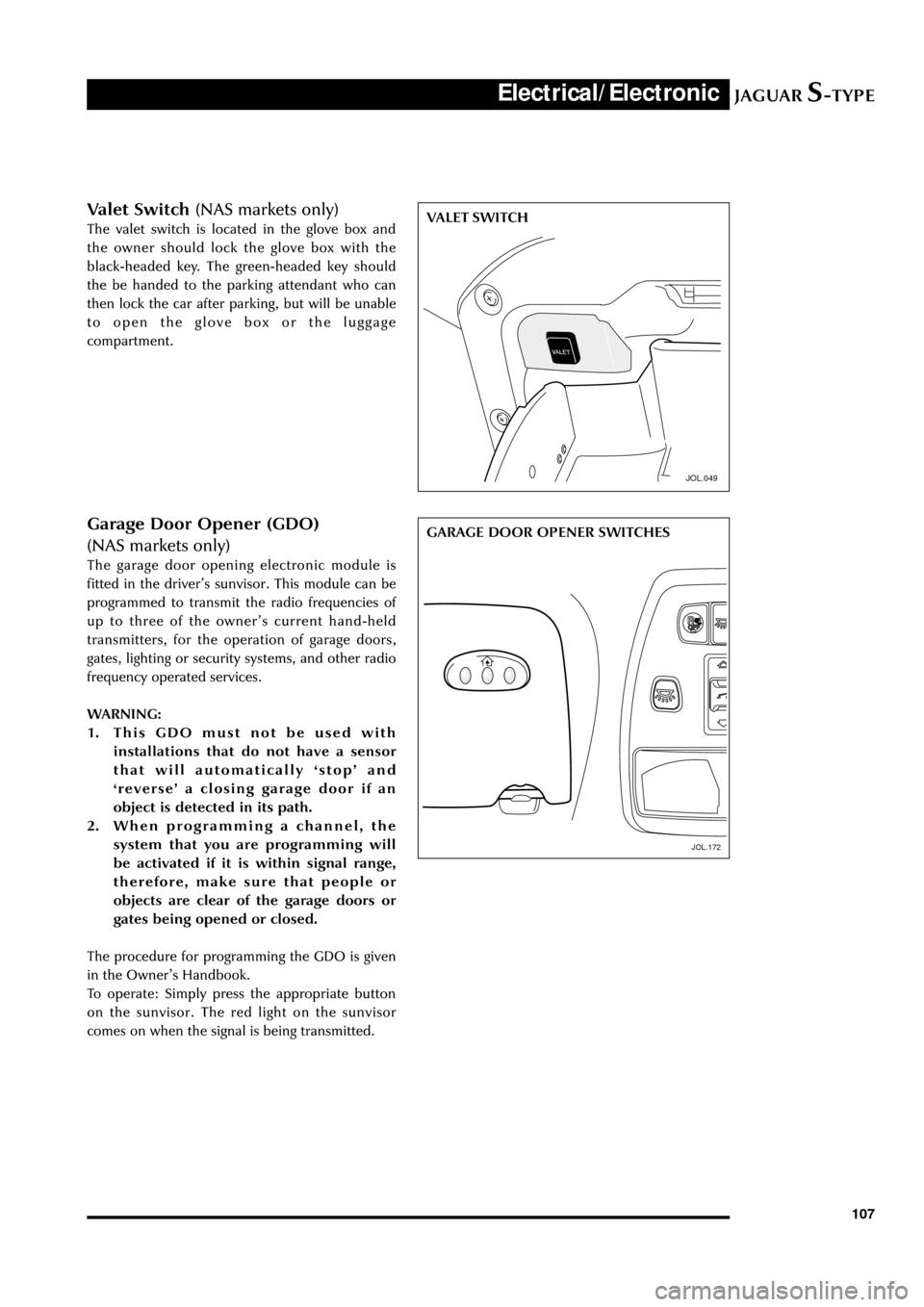
JAGUARS-TYPEElectrical/Electronic
107
Valet Switch (NAS markets only)
The valet switch is located in the glove box and
the owner should lock the glove box with the
black-headed key. The green-headed key should
the be handed to the parking attendant who can
then lock the car after parking, but will be unable
to open the glove box or the luggage
compartment.
JOL.049
VALET SWITCH
JOL.172
GARAGE DOOR OPENER SWITCHESGarage Door Opener (GDO)
(NAS markets only)
The garage door opening electronic module is
fitted in the driverÕs sunvisor. This module can be
programmed to transmit the radio frequencies of
up to three of the ownerÕs current hand-held
transmitters, for the operation of garage doors,
gates, lighting or security systems, and other radio
frequency operated services.
WARNING:
1. This GDO must not be used with
installations that do not have a sensor
that will automatically ÔstopÕ and
ÔreverseÕ a closing garage door if an
object is detected in its path.
2. When programming a channel, the
system that you are programming will
be activated if it is within signal range,
therefore, make sure that people or
objects are clear of the garage doors or
gates being opened or closed.
The procedure for programming the GDO is given
in the OwnerÕs Handbook.
To operate: Simply press the appropriate button
on the sunvisor. The red light on the sunvisor
comes on when the signal is being transmitted.
JOL.172
Page 113 of 133

JAGUARS-TYPEElectrical/Electronic
108
Security and Locking Systems
Introduction
The following security and locking features are
available but vary by market or options:
¥ Key barrel on driverÕs side only
¥ Encrypted engine immobilization by ignition
key transponder
¥ Radio frequency remote fob
¥ Central locking by key and remote fob
¥ Double locking (not in North America, Japan,
Taiwan)
¥ Drive away door locking
¥ Mechanical child locks on rear doors
¥ Perimeter alarm of doors, bonnet, trunk
¥ Intrusion sensing, ultrasonically sensed (not
in North America, Japan, Taiwan)
¥ Inclination (tilt) sensing (Dealer fit accessory)
¥ Panic alarm, fob operated (certain markets)
¥ Trunk lock isolate (valet lockout, see page
107) - North America only
¥ Electro/mechanical steering column lock
The following convenience features are included
either as standard or optional features:
¥ Remote fob operated driverÕs seat, door
mirrors and steering column memory recall
(two memories)
¥ Remote fob operated trunk lid release
¥ Key operated global close (sliding roof and all
windows)
¥ Key and fob remote-operated global open
(sliding roof and all windows)
¥ Trunk lid and fuel flap interior release buttons
¥ Trunk release button in trunk plinth
¥ Emergency key lock barrel under trunk plinth.
System Description
The security system is controlled by a driver door
control module (DDCM). When activated
unauthorized entry in to the vehicle is detected by
the courtesy lamp switches. When the alarm is
triggered, the system flashes the turn signal lamps
and sounds the alarm system horns.
The passive anti-theft system (PATS) is a feature to
prevent the vehicle being driven away by an
unauthorized person. The PATS system consists of
electronically coded keys, a transceiver and is
controlled by the Instrument Pack. When the
ignition is switched to position ÔIIÕ, the transceiver
energises the ignition key to read its electroniccode that is transmitted back. If the read code
equals a stored code in the control module, the
steering column is unlocked and the powertrain
control module (PCM) will let the engine start.
Otherwise, starting of the engine is disabled
(through the starter disable relay and the PCM).
The security indicator LED provides the driver
with the status of the PATS or security system. If
the security system is armed the light will flash
when the ignition is switched OFF. The PATS light
will illuminate when the key is inserted into the
ignition lock and turned to position ÔIIÕ. It will stay
illuminated until the system has carried out its test
on the key. If the system detects a fault, it will
flash the LED for 1 minute, and then flash out the
corresponding 2 digit fault code.
Security System Operating Components
Key to illustration on the following page:
1. Four button transmitter (North America/Rest
of the World)
2. Three button transmitter (Europe/Japan)
3. Trunk release switch
4. Trunk compartment actuator
5. Intrusion sensor
6. Door actuator
7. Driver door control module
8. Data link connector
9. General electronic control module
10. PATS transceiver module
11. Hood switch
12. Security LED
13. Horns
14. Security horn
15. Security sounder
16. Intrusion sensor
17. Rear electronic control module
Page 119 of 133

JAGUARS-TYPEElectrical/Electronic
114
Alarms and Audible Signals
Note:In certain markets, legislation prohibits the
use of audible confirmation signals. In such cases,
the sound source has been removed from the
system.
Audible Signals
An audible signal will sound when a door is
opened using a key if the vehicle has been armed
(Europe only). This mode can be cancelled within
15 seconds of opening the door, by disarming the
security system using the key-ring transmitter or
by switching the ignition to position ÔIIÕ.
Error Signal
The direction indicators will flash five times
whenever one of the following conditions is
present:
¥ If any door is open when an attempt to ÔarmÕ
the security system is made.
¥ The luggage compartment or the bonnet is
not properly closed when an attempt to ÔarmÕ
the security system is made.
¥ If there is an electrical failure within the
intrusion sensing system, if fitted, and an
attempt to ÔdisarmÕ the security system is
made.Full Alarm
Once armed, any of the following circumstances
will create a full alarm state and sound the horns
and flash the direction indicators:
¥ Opening a door, luggage compartment lid
(except with transmitter) or bonnet.
¥ Movement in the passenger area (if intrusion
sensors are fitted).
¥ Using a key in the ignition switch which is not
programmed to the vehicle.
¥ If the driverÕs door is opened with a key
(European markets only) after a 15 second
delay.
¥ If the inclination sensor (if fitted) is activated.
Intrusion Sensing (when fitted)
A further enhancement to the security system is
the addition of intrusion sensing. When the
vehicle is armed and double-locked, movement
within the vehicle interior will activate the alarm.
When the security system is disarmed the
intrusion sensors are also disarmed.
Panic Alarm (when fitted)
When in or near the vehicle, the alarm can be set
off to deter a possible offender. For this feature to
operate, the key must not be in the ignition
switch.
Pressing the panic button on the key-ring
transmitter will activate the ÔPanic AlarmÕ.
The Panic Alarm will sound for the normal full
alarm period. The alarm is stopped by putting the
key into the ignition switch and turning to position
ÔIIÕ.
The key-ring transmitter can be used to cancel the
Panic Alarm by pressing either the panic button or
the unlock button.
Inclination (tilt) Sensing Protection (Dealer
fit option)
This feature protects against unauthorized towing
away or jacking up. When the vehicle is double-
locked and armed, any tilting of the vehicle, such
as jacking or lifting, will activate the alarm.
Note:If the vehicle is being transported by road,
rail or sea, the vehicle should not be double-
locked. This prevents the inclination system from
being armed and sounding the alarm as the
vehicle pitches and rolls.
When the security system is disarmed the
inclination sensor is also disarmed.
D.418.232
INTRUSION SENSOR
Page 127 of 133
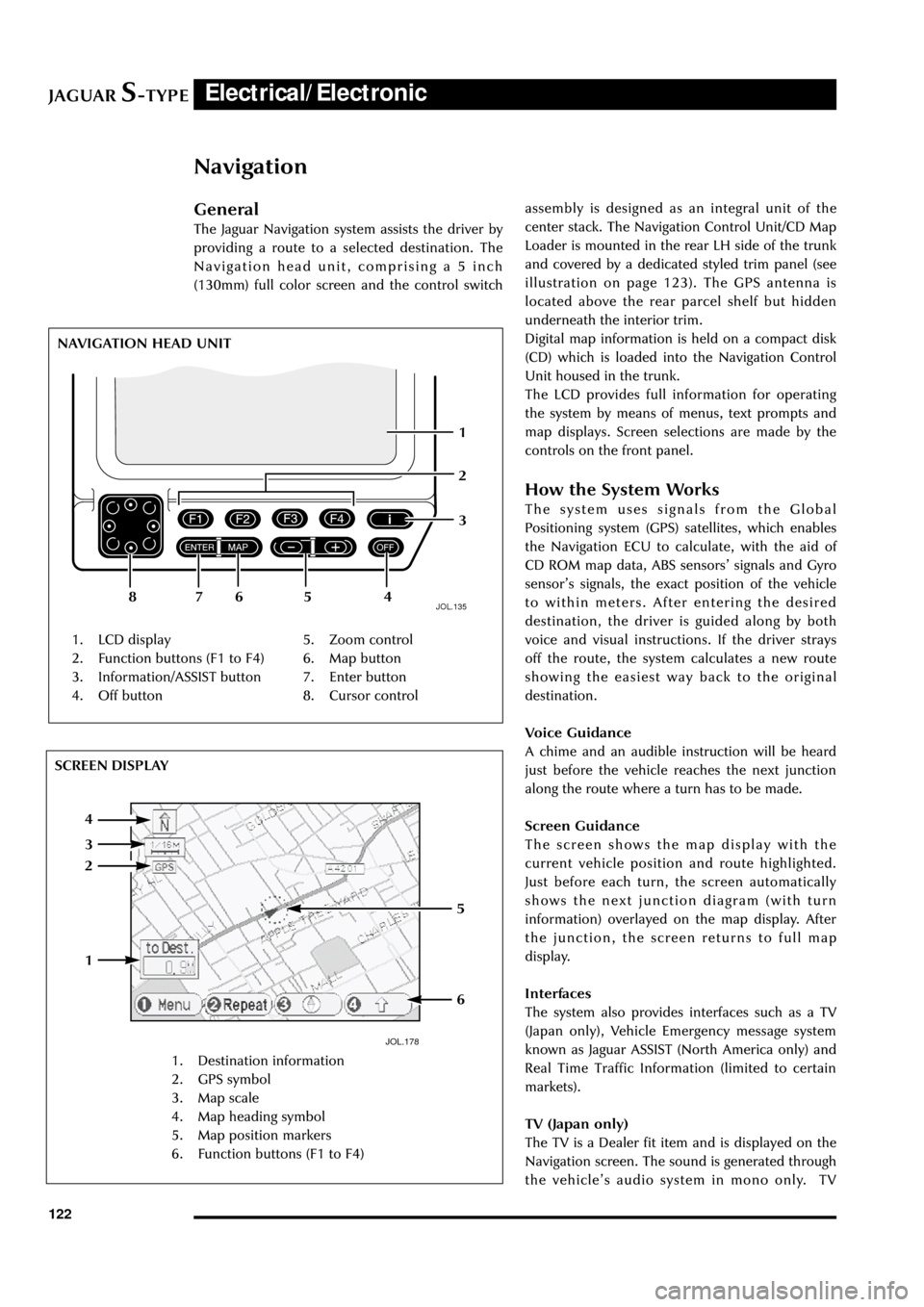
JAGUARS-TYPE
Navigation
Electrical/Electronic
122
General
The Jaguar Navigation system assists the driver by
providing a route to a selected destination. The
Navigation head unit, comprising a 5 inch
(130mm) full color screen and the control switch
JOL.135
1. LCD display
2. Function buttons (F1 to F4)
3. Information/ASSIST button
4. Off button5. Zoom control
6. Map button
7. Enter button
8. Cursor control NAVIGATION HEAD UNIT
1
654
3
2
78assembly is designed as an integral unit of the
center stack. The Navigation Control Unit/CD Map
Loader is mounted in the rear LH side of the trunk
and covered by a dedicated styled trim panel (see
illustration on page 123). The GPS antenna is
located above the rear parcel shelf but hidden
underneath the interior trim.
Digital map information is held on a compact disk
(CD) which is loaded into the Navigation Control
Unit housed in the trunk.
The LCD provides full information for operating
the system by means of menus, text prompts and
map displays. Screen selections are made by the
controls on the front panel.
How the System Works
The system uses signals from the Global
Positioning system (GPS) satellites, which enables
the Navigation ECU to calculate, with the aid of
CD ROM map data, ABS sensorsÕ signals and Gyro
sensorÕs signals, the exact position of the vehicle
to within meters. After entering the desired
destination, the driver is guided along by both
voice and visual instructions. If the driver strays
off the route, the system calculates a new route
showing the easiest way back to the original
destination.
Voice Guidance
A chime and an audible instruction will be heard
just before the vehicle reaches the next junction
along the route where a turn has to be made.
Screen Guidance
The screen shows the map display with the
current vehicle position and route highlighted.
Just before each turn, the screen automatically
shows the next junction diagram (with turn
information) overlayed on the map display. After
the junction, the screen returns to full map
display.
Interfaces
The system also provides interfaces such as a TV
(Japan only), Vehicle Emergency message system
known as Jaguar ASSIST (North America only) and
Real Time Traffic Information (limited to certain
markets).
TV (Japan only)
The TV is a Dealer fit item and is displayed on the
Navigation screen. The sound is generated through
the vehicleÕs audio system in mono only. TV
JOL.178
1. Destination information
2. GPS symbol
3. Map scale
4. Map heading symbol
5. Map position markers
6. Function buttons (F1 to F4)
1
6
5
4
3
2 SCREEN DISPLAY
Page 128 of 133
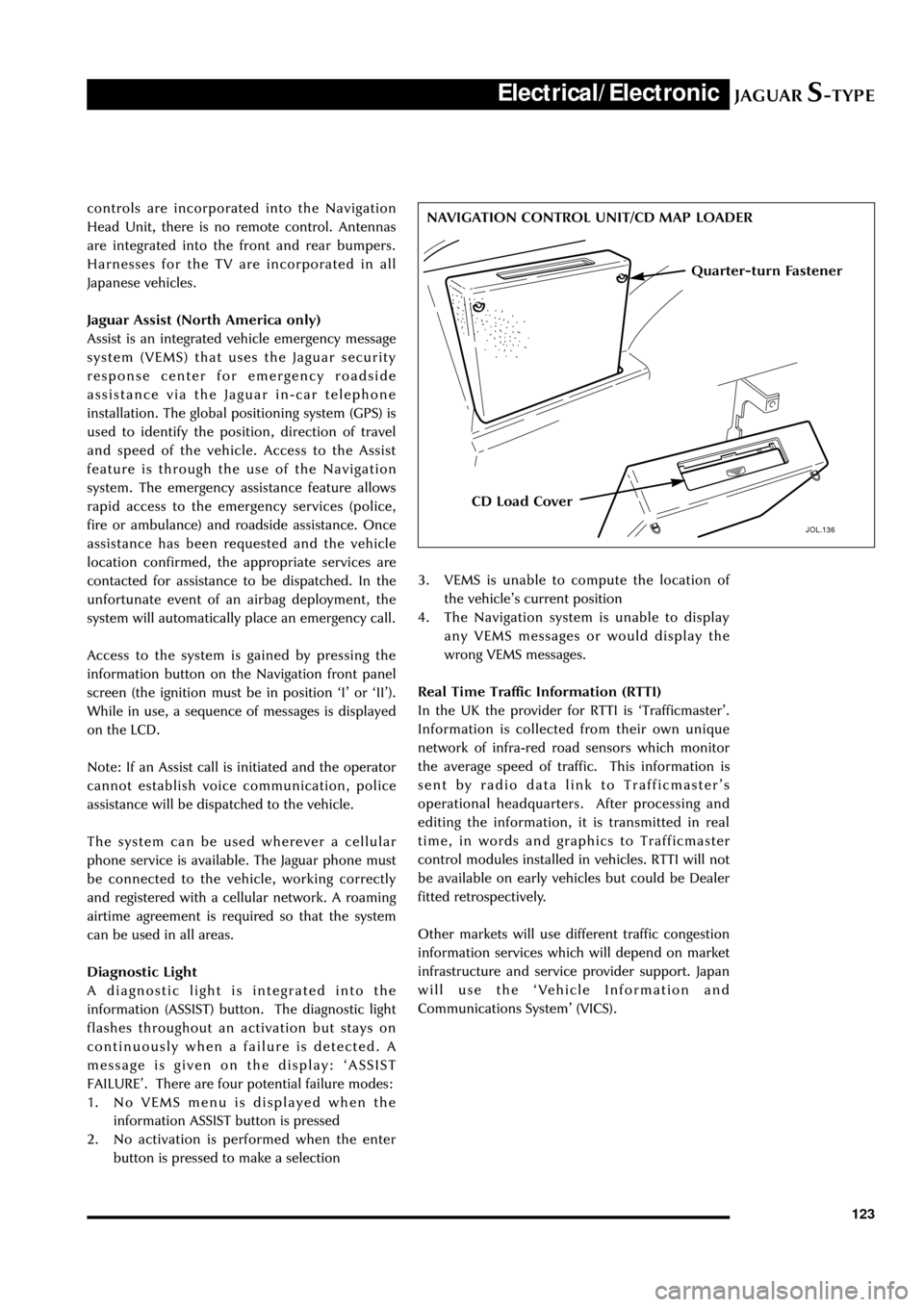
JAGUARS-TYPEElectrical/Electronic
123
JOL.136
Quarter-turn Fastener
CD Load Cover
NAVIGATION CONTROL UNIT/CD MAP LOADER controls are incorporated into the Navigation
Head Unit, there is no remote control. Antennas
are integrated into the front and rear bumpers.
Harnesses for the TV are incorporated in all
Japanese vehicles.
Jaguar Assist (North America only)
Assist is an integrated vehicle emergency message
system (VEMS) that uses the Jaguar security
response center for emergency roadside
assistance via the Jaguar in-car telephone
installation. The global positioning system (GPS) is
used to identify the position, direction of travel
and speed of the vehicle. Access to the Assist
feature is through the use of the Navigation
system. The emergency assistance feature allows
rapid access to the emergency services (police,
fire or ambulance) and roadside assistance. Once
assistance has been requested and the vehicle
location confirmed, the appropriate services are
contacted for assistance to be dispatched. In the
unfortunate event of an airbag deployment, the
system will automatically place an emergency call.
Access to the system is gained by pressing the
information button on the Navigation front panel
screen (the ignition must be in position ÔIÕ or ÔIIÕ).
While in use, a sequence of messages is displayed
on the LCD.
Note: If an Assist call is initiated and the operator
cannot establish voice communication, police
assistance will be dispatched to the vehicle.
The system can be used wherever a cellular
phone service is available. The Jaguar phone must
be connected to the vehicle, working correctly
and registered with a cellular network. A roaming
airtime agreement is required so that the system
can be used in all areas.
Diagnostic Light
A diagnostic light is integrated into the
information (ASSIST) button. The diagnostic light
flashes throughout an activation but stays on
continuously when a failure is detected. A
message is given on the display: ÔASSIST
FAILUREÕ. There are four potential failure modes:
1. No VEMS menu is displayed when the
information ASSIST button is pressed
2. No activation is performed when the enter
button is pressed to make a selection3. VEMS is unable to compute the location of
the vehicleÕs current position
4. The Navigation system is unable to display
any VEMS messages or would display the
wrong VEMS messages.
Real Time Traffic Information (RTTI)
In the UK the provider for RTTI is ÔTrafficmasterÕ.
Information is collected from their own unique
network of infra-red road sensors which monitor
the average speed of traffic. This information is
sent by radio data link to TrafficmasterÕs
operational headquarters. After processing and
editing the information, it is transmitted in real
time, in words and graphics to Trafficmaster
control modules installed in vehicles. RTTI will not
be available on early vehicles but could be Dealer
fitted retrospectively.
Other markets will use different traffic congestion
information services which will depend on market
infrastructure and service provider support. Japan
will use the ÔVehicle Information and
Communications SystemÕ (VICS).
Page 131 of 133
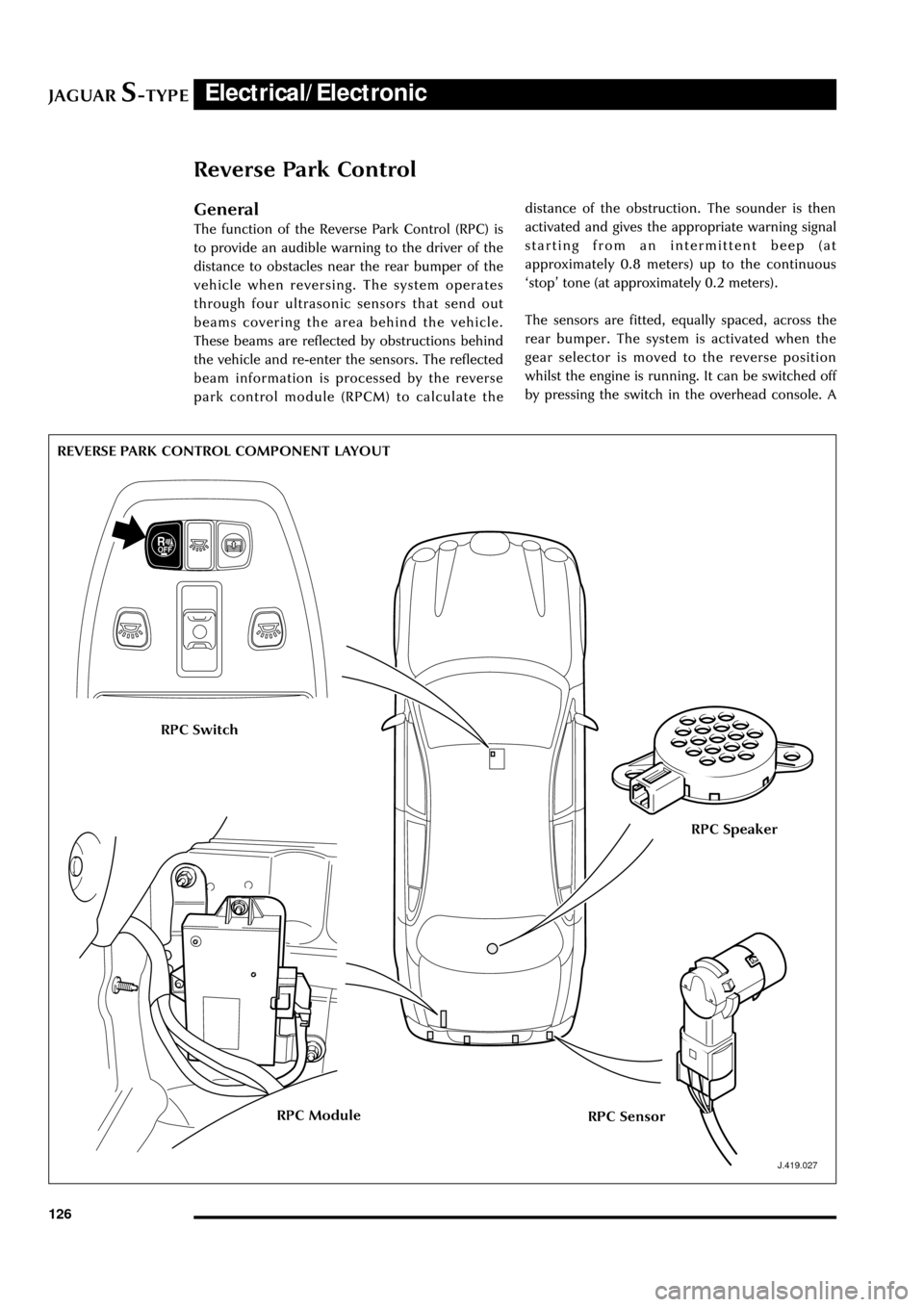
JAGUARS-TYPEElectrical/Electronic
126
Reverse Park Control
General
The function of the Reverse Park Control (RPC) is
to provide an audible warning to the driver of the
distance to obstacles near the rear bumper of the
vehicle when reversing. The system operates
through four ultrasonic sensors that send out
beams covering the area behind the vehicle.
These beams are reflected by obstructions behind
the vehicle and re-enter the sensors. The reflected
beam information is processed by the reverse
park control module (RPCM) to calculate the
J.419.027
REVERSE PARK CONTROL COMPONENT LAYOUT
RPC Switch
RPC ModuleRPC Sensor
RPC Speaker distance of the obstruction. The sounder is then
activated and gives the appropriate warning signal
starting from an intermittent beep (at
approximately 0.8 meters) up to the continuous
ÔstopÕ tone (at approximately 0.2 meters).
The sensors are fitted, equally spaced, across the
rear bumper. The system is activated when the
gear selector is moved to the reverse position
whilst the engine is running. It can be switched off
by pressing the switch in the overhead console. A
Page 132 of 133

JAGUARS-TYPEElectrical/Electronic
127 red indicator light in the switch illuminates when
the system is switched off. It is reset every time
the ignition is cycled.
Should there be a failure in the system, the red
indicator light in the switch is constantly
illuminated and a fault code is logged in the
PACM.
The reversing aid comprises the following
components:
¥ Harness
¥ PACM located on the LH side of the spare
wheel well
¥ Speaker located under the trim on the rear
parcel shelf
¥ Four sensors located in the bumpers (see
page 13)
¥ Sensor holders located in the bumpers